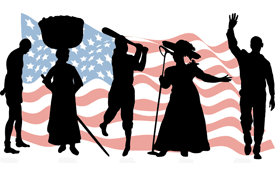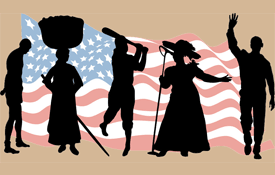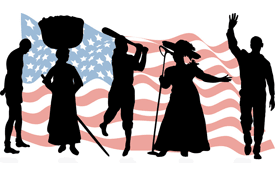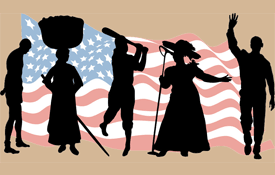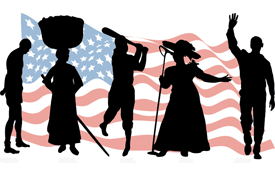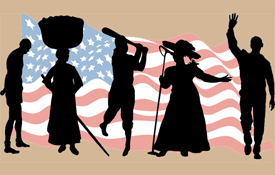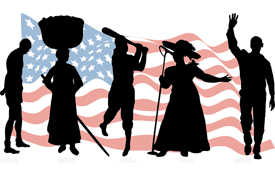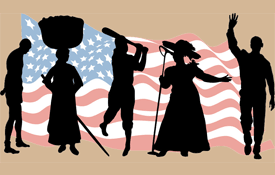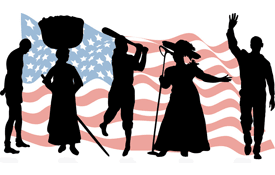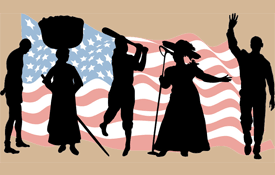Categories
-
0 Jerome Ringo - Earth Day Environmental Leader
- History
- by Hugh Smith
- 04/21/2006
Saturday, April 22, is Earth Day. When the first Earth Day was celebrated in 1970, protection of the environment was not an activity automatically associated with people of color in general, and African Americans in particular. Thirty-six years later, black history people are making contributions in all sectors of society, including the environmental movement. In 2005, Jerome Ringo was elected Chairman of the Board of the National Wildlife Federation, the largest conservation environmental organization, with over 4 million members. Ringo is the first African American elected Chairman of the Board of the NWF. The National Wildlife Federation has been dedicated to protecting America's wildlife since 1936. An Earth Day salute to Jerome Ringo.
-
0 African American Aviators: Coleman, Brown, Bluford and Young
- History
- by Hugh Smith
- 04/19/2006
Recently, Yvonne from St. Petersburg, Florida was curious about the first black woman commercial airline pilot. According to Empower Encyclopedia: Bessie Coleman, (1892-1926), is given credit as the first black woman in the United States to receive a pilot’s license. Willa Brown started flying in 1934. She was born in Kentucky, went to school in Indiana, became a teacher in Gary, and learned to fly in Chicago. Willa Brown obtained her commercial pilot's license in 1937. Pan American World Airways First Officer and pilot Otis B. Young, of Washington D.C., was the first African American to fly a 747 jumbo jet. In 1970, the former Air Force aviator flew the first 747 non-stop flight between London and Los Angeles. Jill Brown was accepted by the Navy in 1974 as the first black woman for pilot training. In 1978, Jill Brown became the first African American woman pilot/First Officer with a major carrier: Texas International Airlines. In the space age, Guion Stewart Bluford Jr. became the first black American astronaut in space aboard the space shuttle Challenger on August 30, 1983.
-
0 Do you know your Black History as well as Joe?
- History
- by Hugh Smith
- 04/14/2006
Cedar City, Utah's Joe Baker teases your head with this tough brain buster black history quiz he's prepared... Questions: 1. Which political party was founded in 1854 for the purpose of ending slavery? 2. Who said "The Republican Party would have the American flag and swastika flying side by side?" 3. Which political party used the 1868 campaign slogan "This is a white man's country: let white men rule?" 4. Who appointed former Ku Klux Klansman Hugo Black to the Supreme Court? 5. Which party did the "Great Emancipator" Abraham Lincoln belong to? 6. Who is the only current member of congress who was once a "Grand Kleagle" in the Ku Klux Klan? 7. In a 2001 interview who said "There are white n--s. I have seen a lot of white n--s in my time?" 8. What percent of Democrats voted for the Thirteenth Amendment that made slavery unconstitutional? 9. Who deployed the 82nd Airborne to desegregate Little Rock Schools over the resistance of democratic Gov. Orval Faubas? 10. Who first used the "Willie Horton" issue against Michael Dukakis? 11. Which senator led a 14-hour filibuster to delay the 1964 Civil Rights Act? 12. Who ended this filibuster allowing passage of the CRA? 13. Which party cast the highest percentage of votes for the 1964 CRA? 14. What percent of Democrats voted for the Fourteenth Amendment guaranteeing equal protection? 15. Which president said "it is all so terribly true" after a private screening of D.W. Griffith's racist film, "Birth of a Nation?" 16. Which party did the first black U.S. House member and first black U.S. Senator belong to? 17. Who appointed the first black 4-star Air Force and Army generals? 18. Who appointed the first black National Security Advisor? 19. Who appointed the first and second black Secretaries of State? 20. Who said that it gave him "psychological gratification" to spit into the soups and salads of white customers while he worked as a waiter? 21. A 2005 blog contained a racist parody of a black U.S. Senate candidate in minstrel makeup and exaggerated lips with the caption: "I's Simple Sambo and I's running for the Big House." An official party Web site linked to this blog. Name the candidate and Web site. Answers: 1. Republican 2. NAACP Chairman Julian Bond 3. Democratic 4. Democratic president FDR 5. Republican 6. Democratic WV senator Robert Byrd 7. Robert Byrd again 8. Democrats: House 22 percent; Senate 37 percent; Republicans 100 percent 9. Republican President Eisenhower 10. Al Gore Jr., 1988 Democratic primaries 11. Democrat Al Gore, Sr. 12. Republican Sen. Everett 13. Republicans 80 percent, Democrats 64 percent 14. Not one congressional Democrat voted for it vs. 94 percent of Republicans 15. Democratic President Woodrow Wilson 16. Republican 17. Republican President Reagan 18. Republican President George H.W. Bush 19. Republican President George W. Bush 20. Jesse Jackson 21. Maryland U.S. Sen. candidate Republican Michael Steele; the link was on the official Web site of the Democratic Senatorial Campaign Committee. In addition, a DSCC staffer recently pleaded guilty to fraudulently obtaining Steele's credit history. DSCC Chairman Sen. Charles Schumer refuses to apologize for the link or stolen credit history. ---------- Ok, Joe has put together a whale of a quiz. It's the real deal. He's done his homework. You say you're ready for more!...then check out some more questions. You can choose from a variety of different genres, and rate the questions, in our own online collection of black history quizzes we've created.
-
0 19th Century Wonder Woman in the Patent House
- Inventors
- by Hugh Smith
- 04/10/2006
When it comes to roll call time for inventors, guys generally get all the credit. Creativity has no gender boundary, so here's a quick salute to the first African American woman to receive a U.S. patent, way back in 1885. On July 14, 1885, a Chicago furniture storeowner received patent number 322,177 for a clever convertible bed design. Her cabinet bed was literally a bed in a box. The intricate mechanical folding enclosure looked more like an antique desk in disguise. Popping open the top of the cabinet revealed a two-winged apparatus below, identical halves of the bed, made to balance on the cabinet's sturdy center of gravity providing a restful platform for sleep. Sarah Goode had the intuition, the wisdom, and the smarts to dream up this masterpiece.
-
- Civil Rights
- by Hugh Smith
- 04/04/2006
The William Frantz Public School in New Orleans may not have any significance to you, but for Ruby Bridges, her elementary school is an important part of Louisiana and U.S. history. We received a question from Victoria Hart asking about the fascinating story of Ruby Bridges. Ruby was thrust into the spotlight as a six year old attending kindergarten on November 14, 1960, just months after a federal court ordered New Orleans public schools to desegregate. Read Ruby's reflections about how a brave six year old girl got some life lessons in school she'll never forget. It's the real Ruby Bridges story, from the lips of one of only four black students who would integrate the New Orleans public school system in the Fall of 1960.
-
- Music
- by Hugh Smith
- 04/01/2006
His spirit lives on inside of marvelously magic melodies, flirtatious songs of fantasy, and devilishly seductive R&B from the golden era of classic soul. Marvin Gaye was born on April 2, 1939, and died on April 1, 1984. Years from now, when the Motown pioneers are closely studied, Marvin Gaye will rise to the top as an important entertainer, who, despite his immense talent, was not without his faults. The Motown Alumni Association, Los Angeles Chapter, started a world wide campaign a couple of years ago lobbying the U.S. Postal Service for a commemorative stamp for Marvin. The committee in charge of issuing commemorative stamps for the U.S. Postal Service has turned down the "Marvin stamp" several times. We don't have a Marvin Gaye stamp yet, but plenty has been written about the enigma of Marvin Gaye. According to Dorothy Ferebee in her review of Michael Eric Dyson's Mercy, Mercy, Me: The Art Loves and Demons of Marvin Gaye," Dr. Dyson examines the effect of Marvin Gaye's music on the socio-political climate of the sixties, seventies and eighties. Ferebee adds that Dyson attempts to unravel the mysteries of Gaye's loves and passions for Anna Gordy and Janice Hunter, his two wives, and his reputed romantic relationship with Tammi Terrell. Marvin's album, "What's Goin' On," remains one of the most influential thematic collection of songs ever recorded. A technical note...the cover of the original vinyl album titles the work as "What's Going On." That title is also printed on the lp, while the spine of the album cover says: "What's Goin' On." Marvin was way ahead of his time, and departed way to early.
-
0 Black History Heavyweights – the Press and Dr. John Hope Franklin
- History
- by Hugh Smith
- 03/28/2006
91 year old Dr. John Hope Franklin was recently honored with a lifetime achievement award from the National Newspaper Publishers Association. The NNPA is a 65-year-old federation of 200+ black community newspapers across the United States. Dr. Franklin, holding a doctorate in history from Harvard, is the James B. Duke Professor Emeritus of History at Duke University. In accepting his award, Dr. Franklin stressed the importance of keeping the institution of the black press alive. Here are some quick black press highlights to remember… The USA’s first African American newspaper, Freedom’s Journal, was founded in 1827 in New York. Frederick Douglass founded The North Star in Maryland in 1847. William Monroe Trotter founded the Boston Guardian in 1901. Robert S. Abbott founded The Chicago Defender in 1905, which remains the only daily African American newspaper. John Hope Franklin is a legendary icon in the study of black history. He’s best known for his classic book, "From Slavery to Freedom: A History of African Americans," (now in its seventh edition). Even at age 11, there was a connection between Franklin and the black press. When he accepted his lifetime achievement NNPA Award, Dr. Franklin revealed that he was a carrier of NNPA newspapers The Chicago Defender, and The Pittsburgh Courier, in the 1920’s and 1930’s. From paper boy to man of letters, Dr. John Hope Franklin, Ph.D., black history scholar superstar.
-
0 Number 42 is gone but the Legacy of Jackie Robinson Lives
- Sports
- by Hugh Smith
- 03/22/2006
Jackie Robinson was the first black 20th Century major league baseball player. He signed a contract with the Brooklyn Dodgers minor league Montreal Royals in 1945, before joining the big club in 1947. Here are some of Jackie's career highlights: First Major League Rookie of the Year, 1947. National League's Most Valuable Player, 1949. National League batting champion with a .342 average in 1949. Stolen base leader in 1947 and 1949. Six-time National League All-Star, 1949 - 1954. Jackie Robinson's playing career ended in 1956. He was voted into baseball's Hall of Fame in 1962, and was out of the game by 1964. When baseball celebrated the 50th anniversary of Robinson's breakthrough in 1997, his number was retired by every major league team. Since 2004, every April 15th is celebrated in baseball as Jackie Robinson Day to acknowledge his social legacy to America and the world. The Jackie Robinson Foundation provides four-year college scholarships to minority students who have a demonstrated record of academic distinction, leadership capacity, and financial need. The foundation is currently supporting 266 Jackie Robinson Foundation Scholars attending 93 colleges and universities in 33 different American states and the District of Columbia. March 31, 2006, is this year's application deadline for students to take advantage of the Jackie Robinson Foundation scholarship.
-
0 Edison, Latimer, Dickinson - Fathers of Invention
- Inventors
- by Hugh Smith
- 03/20/2006
In the world of black history people, there are many unique personalities. Master organ designer Joseph Dickinson is one of them. In the late 19th century, Dickinson won numerous awards for his organs, but he didn't stop there. Expanding on his technical knowledge of musical instruments, Dickinson won several patents for the player piano. His company perfected a system of controlling the volume of mechanical musical instruments, as well as proudly obtaining a number of phonograph patents...which leads us to Thomas Edison. Thomas Edison didn't invent all of those magical devices he's given credit for by himself. The phonograph? Yes, Edison gets the credit, but he had several bright and energetic understudies who made important contributions to his research and ultimate patents. Lewis H. Latimer, (1848-1928), invented and patented the first electric light bulb with a carbon filament (1882). He joined the Thomas A. Edison Company in 1886 to become the only black engineer on Edison's staff. Edison later developed the carbon filament into the modern light bulb.
-
0 Black History Month Collectible Trading Cards
- Entertainment
- by Hugh Smith
- 03/16/2006
Direct from Canada, where the country miles stretch out to the horizon, and wheat fields abound a plenty, comes a Black History Trading Cards collection, from the picturesque urban enclave of Toronto. Luanga Nuwame, pictured below, a 28 year old entrepreneur, has created a 24 card collection featuring Rosa Parks, Dr. Martin Luther King Jr., Malcolm X, Nelson Mandela, George Dixon, Marcus Garvey, and more. Ancient African legends Shaka Zulu, Taharka and Makeda are also featured. Just 5000 copies are available, with a share of the proceeds donated to both one American and one Canadian charitable organization.
